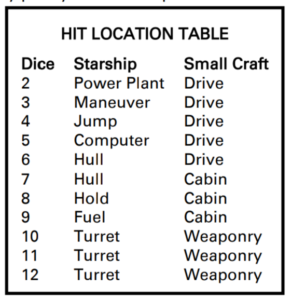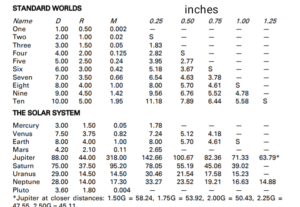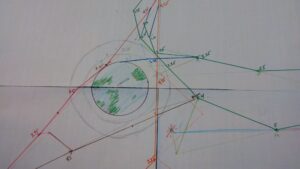Vector Based Traveller Combat
The implementation of vector-based spaceship combat in Traveller is easy. It’s the strategy that results from the process that’s hard. Like chess, the rules are simple, but lead to a wealth of complex puzzles and potential pitfalls for the unwary.
Marc Miller gives Traveller (1977) players two options:
- Just like, whatever, man. In four short paragraphs he allows for simplified combats that reduce to trading a handful of shots before one ship gets away. It works great when you have two ships in a black endless void with no real need for detailed positioning or tactics. Most Traveller players use this system to good effect at the table.
- Hard Buds of SF wet dream. In four long pages, he lays out the steps for a more traditional wargame complete with alternating activations, fire-counterfire, missile launches, gravity well effects, and even hit location tables.
 The vector diagrams and the cold equations of the latter look pretty scary to most players, whose eyes glaze over as they reach past these pages to the first method. If you take the time to lay out the process and slowly work through the rules, what you find is an interesting implementation of hard-SF space drive mechanics that requires a lot of forethought but no more cognitive load than a typical 3e or later edition of D&D. They also open up a wealth of possibilities when it comes to environmental hazards such as passing asteroids, gravity wells, and even docking maneuvers during combat.
The vector diagrams and the cold equations of the latter look pretty scary to most players, whose eyes glaze over as they reach past these pages to the first method. If you take the time to lay out the process and slowly work through the rules, what you find is an interesting implementation of hard-SF space drive mechanics that requires a lot of forethought but no more cognitive load than a typical 3e or later edition of D&D. They also open up a wealth of possibilities when it comes to environmental hazards such as passing asteroids, gravity wells, and even docking maneuvers during combat.
As a brief aside, it takes about ten minutes to resolve a single ten minute turn of Traveller space combat. It took me that long to do a 2-on-2 ship fight with a few missiles, scattered around a planet. Which means that in proto-Traveller shoot-em-ups you are gaming in 1:1 time! Who knew?
To make your life easier, players should have a roll of butcher paper or tape a few 11×17 sheets of paper together and break out the rulers and compasses. The latter are only really needed when drawing planets and their gravity wells. You can get by just fine with a ruler. To make things as easy as possible, you draw a light line showing your ship’s momentum (where you will end up if you apply no thrust – or change of speed or heading – at all), then you add another line segment to that in whatever direction you want with a length up to your maximum thrust. The end of that line shows your ending location, and connecting the ship’s starting point to its ending point tells you what your actual movement and direction were.
Let’s take a look at a scale-free example:
 Your “Actual Movement” from this turn becomes your “Momentum” line on your next turn. If we turn the page to the end of Turn 3 it might look a little something like this:
Your “Actual Movement” from this turn becomes your “Momentum” line on your next turn. If we turn the page to the end of Turn 3 it might look a little something like this:
Note that with no ‘burn’ of ship’s fuel your little rocket can continue on forever at its current speed. Which makes fuel conservation a very important consideration. Every turn of thrust costs a ton of fuel, and once you’ve taken a few hits to your tanks you might find yourself facing a long slow journey into nothing. Surrendering to the tender mercies of your captors might be the only way to save your life! Or you might decide to call off the pursuit of a vessel that has better fuel stocks than you do since catching him might leave you headed away from home with not enough fuel to turn around, get home in a reasonable amount of time, and have enough go-juice left to brake once you get there. Fuel winds up working as a sort of “Hit Points” for your ships.
 It’s real, and it’s tense, and it forces you to think about what you’re doing. Sure, you could do a max burn every turn to get where you need to go, but if you’re going too fast when you get there, you won’t be able to stop in time to secure your victory conditions. Going faster means you’re making wider turns, turns that could allow those nimble missiles to catch you, or let you rip right past them going too fast for them to turn and get you. You really have to think three moves ahead, and that’s where things get the most complicated and the most rewarding.
It’s real, and it’s tense, and it forces you to think about what you’re doing. Sure, you could do a max burn every turn to get where you need to go, but if you’re going too fast when you get there, you won’t be able to stop in time to secure your victory conditions. Going faster means you’re making wider turns, turns that could allow those nimble missiles to catch you, or let you rip right past them going too fast for them to turn and get you. You really have to think three moves ahead, and that’s where things get the most complicated and the most rewarding.
And when the logistics of space fights intersects with the economics of the RPG elements, things get even more fun. Sure, you could launch a full missile salvo to deter pursuit, but that might cost you a quarter of a million space simoleons. You sure you got the cash for that? Do your clients have that kind of space cabbage in their budget? You might be forced out of necessity to just launch one or two missile instead, risking that they will be enough to get the job done on time and under budget.

In addition to that, Traveller’s spaceship combat game shines when you have meaningful objectives on the table. A handful of ships shooting at each other soon breaks down into a paired die rolling exercise. With ranges of 150 inches on the table, everybody can always see everybody else – barring intervening asteroids or planets – and tactics become ‘roll higher than the other guy’. To get the most out of the system, you’ll want one side to have something more important to do than simply joust with the enemy. Here are a few suggestions:
- One corner of the table is the edge of a gas giant. The protagonist ship is low on fuel and skimming a free top-off while in-system defense boats are trying to hold him off. This gives you a battleground with major vectors of gravity pulling every ship toward their doom. Everyone will have to reserve some power for staying out of the ‘no-go’ zone of the planet’s thick atmo.
- One ship has to deliver a quick payload – cartel style – by passing within a half-inch of a planetary surface and launching a ‘missile’. The missile is actually a drop pod holding an important person or illicit cargo to be recovered later. Can the ship get close enough, at a low enough speed to deliver the payload, and escape before the in-system defense ships can blast him out of space? This forces both players to jockey for shots, control their speed, and account for the motives of the other ships. It can make for a nail-biting experience when one ship is shot to ribbons but has just enough stamina to slip away from its battered pursuit.
- Two small and lightly armed scout ships are running a blockade and have to dock with a defensive installation on a smallish asteroid. Five or six big asteroids are drifting through the area, and with their better maneuverability one of them stands a good chance to make it. They are being chased by a much better armed, but lumbering cruiser. The latter will have to think very carefully about how to navigate the region to keep his lanes of fire open, while ensuring he doesn’t meet with one of the big rocks that would shatter his hull like glass.
Once again, we see how the campaign layer of a wargame adds a wealth of detail and consideration to the tactical aspects. Generating these situations organically through play means that every side has considerations that extend beyond “blast him!” and force them to adopt strategic thinking over short-term advantage.
Here’s a shot of the action when I ran the second scenario:
The red shows the path of the ship delivering a payloa, the orange is a little ship’s gig that needed to be recovered. The two green lines are the defense ships. All other colors are missiles, and you can see that one of them couldn’t avoid slamming into the northern polar ice-cap of the planet. The light lines are momentum and thrust lines, with the darker lines showing actual movement. Each leg of the paths is one turn and you can see this fight took about eight turns to complete, which took about an hour and twenty minutes to play out. An evening’s fun and well worth the effort. The resultant chase saw the recovery of the gig, and successful completion of the mission. One defense boat had its weapons shot away, and the other had its fuel tanks hit so hard that even though it could fight, it couldn’t give chase. You don’t need fights to the death in this game. Just fights to conclusion.
It’s a nice, tight system that blends with the more conventional role-play elements of Traveller, and it works surprisingly well at the tabletop. Maybe you should give it a second look.

